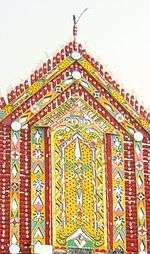Serer-Laalaa
The Serer-Laalaa or Laalaa are part of the Serer ethnic group of Senegambia (Senegal and the Gambia). They live in Laa (var : Lâ), the Léhar Region, which comprises eighteen villages north of Thies and whose inhabitants are Serer-Laalaa. Although the people are ethnically Serer, their language Laalaa (or Lehar) is not a dialect of the Serer-Sine language, but—like Saafi, Noon, Ndut and Palor, one of the Cangin languages.[1]
Other names
Serer-Lehar, Serer-Lehaar, Serer-Laalaa, Serer-Laal, Serer-Lala, Laalaa or just Serer.
Culture
Their language, Laalaa or Lehar, is one of the Cangin languages, closely related to the Noon and Saafi languages, and more distantly related to Serer proper.[2]
They are people who once practiced agro-pastoral activities. Nowadays, agricultural activities predominate their lives. Livestock has been virtually decimated by repeated droughts in the late 1990s. The Laalaa have a younger generation of many intellectuals, a typical Serer traite.[3][4]
Population
The number of speakers of their language is 12,000 in Senegal excluding the Gambia where they are also present.[5] As part of the Serer ethnic group, they collectively make up the third largest ethnic group in Senegal numbering over 1.8 million.[6] The Laalaa (also called Léhar) are mostly found in the north of Thies around the villages of Pambaal, Bargaro and Duuña.[7]
They have about 18 villages namely: Baam, Bapat, Bargaro, Besi, Bicoona, Duuñë, Gogona, Haak, Jalkin, Jëëfuñ, Joy, Kaadaan, Kii, Kolobaan, Pambal, Sowaaboon, Tuuba and Yindën. The Laalaa are also found outside the region of Thies. A large Laalaa community migrated between 1984 and 1986 to Saal Ngeen in the Tambacounda Region.[8]
History

Religion
They practice the Serer religion which involves ancestor veneration, covering all dimensions of life, death and space.[9][10] Some Serer-Laalaas are Christians or Muslims whose conversion is very recent (like most Serer converts to Islam[11]).[11] Both the Christian and Muslim groups mix it with the old Serer religion whilst the Ultra orthodox follow orthodox Serer religion.
See also
Related peoples
Notes
- ↑ Papa Oumar Fall. Language classification: "Sereer dialects" or "cangin languages", African Linguistics Congress WOCAL6 , Cologne 2009
- ↑ Guillaume Segerer & Florian Lionnet 2010. "'Isolates' in 'Atlantic'". Language Isolates in Africa workshop, Lyon, Dec. 4
- ↑ Manirakiza Elvis. "L'impact de la croissance et de l'inégalité sur l'évolution de la pauvreté au Sénégal." Université de Sherbrooke. 2009. ISBN 0-494-42990-9
- ↑ Gilles Blanchet. "Élites et changements en Afrique et au Sénégal." 1983
- ↑ Ethnologue.com. Figure as of 2007
- ↑ Agence Nationale de la Statistique et de la Démographie
- ↑ Papa Oumar Fall. Contribution to phonology Laalaa (Talking Bargaro) , Master Thesis, UCAD, Dakar, 2004-2005
- ↑ Papa Oumar Fall. Pronouns laalaa , DEA, UCAD, Dakar, 2006.
- ↑ Thiaw, Issa Laye, "La Religiosite de Seereer, Avant et pendant leur Islamisation", Ethiopiques no: 54, Revue semestrielle de Culture Négro-Africaine. Nouvelle série, volume 7, 2e Semestre 1991
- ↑ Gravrand, Henry, "La Civilisation Sereer - Pangool", Les Nouvelles Editions Africaines du Senegal, 1990, p 9, ISBN 2-7236-1055-1
- 1 2 Abbey, M T Rosalie Akouele. Customary Law and Slavery in West Africa. Trafford Publishing, 2011. ISBN 1-4269-7117-6, p 481-482
Bibliography
- Gambian Studies No. 17. “People of the Gambia. I. The Wolof. With notes on the Serer and Lebou” By David P. Gamble & Linda K. Salmon with Alhaji Hassan Njie. San Francisco 1985
- Senegambian Ethnic Groups: Common Origins and Cultural Affinities Factors and Forces of National Unity, Peace and Stability. By Alhaji Ebou Momar Taal. 2010
- Elisa Daggs. All Africa: All its political entities of independent or other status. Hasting House, 1970. ISBN 0-8038-0336-2, ISBN 978-0-8038-0336-7
